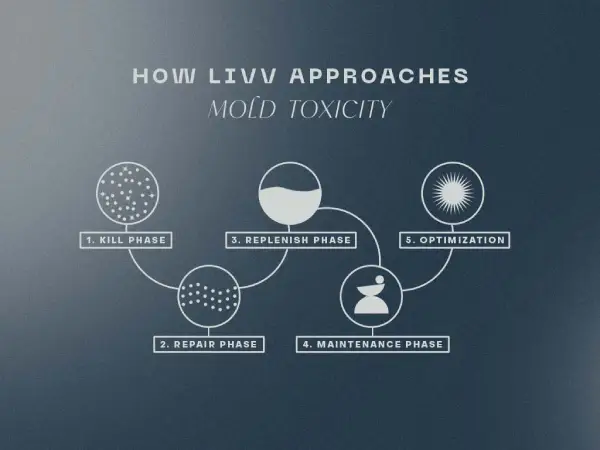Blog
Mold Toxicity: Could You Have It?

The musty, damp smell is one of the quickest ways to know if the environment you’re in has mold.
Most people turn to bathrooms and shower curtains, check under the sink, the basement, around ductwork, and plumbing pipes.
That’s all good since mold thrives in warm moist environments.
But sometimes, mold isn’t as obvious.
It can also grow in drywall, gypsum boards, behind wallpaper, under carpets, in furniture, the HVAC, ceiling tiles, chimneys, and on the roof. Places you won’t typically check when moving houses or doing regular cleaning.
Diagnosing mold toxicity is not easy because there are so many different symptoms tied to it.
If you’re experiencing recurring “cold-like” symptoms along with constant headaches, brain fog, insomnia, unexplained fatigue, and a metallic taste, it may be time to check for mold toxicity.
What is Mold Toxicity?
Mold is simply fungi. The kind that lives in moist environments, both indoors and outdoors.
You can find them in bathrooms, on walls, kitchens, basements, and just about any place that retains moisture for a long period.
Mold spreads and reproduces by producing hardy spores that can survive harsh environments. These spores move through the air, set up base wherever they can find humid surfaces, and mold growth occurs.
Unfortunately, some of these surfaces may be inside our homes, workplaces, and schools.
Breathing in airborne mold particles triggers different reactions in different people.
Some go through life as usual, while others experience bouts of allergies as their bodies fight off the mold.
Allergic reactions include itchy, watery eyes, throat irritation, nasal congestion or runny nose, rashes, coughing, and sneezing.
The real problem, however, starts when you inhale or come into direct contact with toxic chemicals released by some mold known as mycotoxins.
Significant exposure to these poisons may wreak havoc on your system and cause illnesses that go far beyond the common mold allergies we mentioned above.
How Can I Tell If I Have Mold Toxicity?
Mold toxicity is not easily diagnosed since the symptoms overlap with other conditions.
If you recently moved house or jobs or experienced flooding, and now have a case of mysterious symptoms, they may point to mold toxicity.
Symptoms to look out for include:
- Stabbing headaches
- Memory problems, including brain fog and trouble concentrating
- Unexplained fatigue and body weakness
- Muscle cramps, pain in the joints, and recurring nerve pain
- Numbness and tingling
- Eye problems, including light sensitivity
- Shortness of breath
- Worsened asthma and sinuses
- Digestive problems, including abdominal pain and diarrhea
- Metallic taste
- Nausea
- Increased urination
- Night sweats
Can I Self-Medicate Mold Toxicity?
Many health blogs tout gut health cleanses or “sweating it out” as possible ways of detoxing mold exposure.
Doing this at home may not be effective since you really can’t tell the extent of harm or how much detoxifying medicine you need. You also won’t be able to ascertain a drop in exposure levels, by how much, and how fast.
If you suspect mold toxicity, talk to your doctor, who will conduct a proper diagnosis and recommend treatment.
You can also take measures to keep mold out of your living or working space by:
- Turn on the exhaust fan or open your bathroom window when taking a shower.
- Clean your bathroom, under the sink, kitchen, and laundry area with anti-mildew cleaners.
- Hiring a professional mold inspector to assess the risk of mold growth if you’ve recently had water damage or flooding.
- Ensuring water leakages and spills are dried up in under 48 hours. Remove the drywall if it gets wet. Don’t assume all will be dry and dandy.
- Investing in an AC with an allergy-friendly filter or a dehumidifier for humid months.
- Inspecting windows, roofs, kitchens, bathrooms, and other areas prone to water exposure annually.
- Working with a professional home inspector when purchasing an old home. They will provide a detailed water damage inspection along with existing mold problems.
How We Treat Mold Toxicity at LIVV Natural
Unless a patient is aware of mold in their environment, mold toxicity may be hard to diagnose.
The symptoms are varied and reactions may differ from one person to another even under the same exposure.
Through a series of questions, our doctors will seek to pinpoint the root cause of your symptoms.
They will want to know when the symptoms started and if there have been any changes to your physical environment. For example, did you recently move into a new home or place of work? Have you recently experienced flooding or water leakage in the home?
If the doctor suspects mold toxicity, they will order a urine test to check for mycotoxins and which species of mold they are from.
They may also carry out a blood test to assess your immune system’s response to the intruding particles.
Should the results point to mold toxicity, we start the process by identifying the source of the mold.
Where the mold can be removed successfully, we recommend immediate remediation to eradicate the problem. We may also ask the patient to move away from that environment to minimize exposure.
Without this first step, any treatment we offer will be futile since the patient will continue inhaling, ingesting, or touching the same toxic mold.
Depending on the symptoms presented and their severity, the doctor will start you on IV treatments, medications, and other supplementation.
These treatments will help detoxify pathways, support the liver as it cleanses your system, and handle any hormonal imbalances.
They will also recommend a mold-free diet that may comprise vegetables like cauliflower, broccoli, leafy greens, onions and garlic, fresh tomatoes, and zucchini.
You will want to steer clear of sugar, cheese, sour milk products, yeast, mushrooms, and truffles as these foods feed the fungi.
As the treatment progresses, the doctor will monitor the exposure levels to determine how fast they are decreasing. They will let you know once you’re in the clear.
Exposing the Hidden Enemy
Our bodies are continuously exposed to bacteria, viruses, and other microorganisms. Mold is one such harmful microorganism that can get into our bodies through inhalation, ingestion, or touch.
If you suspect your symptoms stem from exposure to mold, call us today and let us help you get back to good health.


